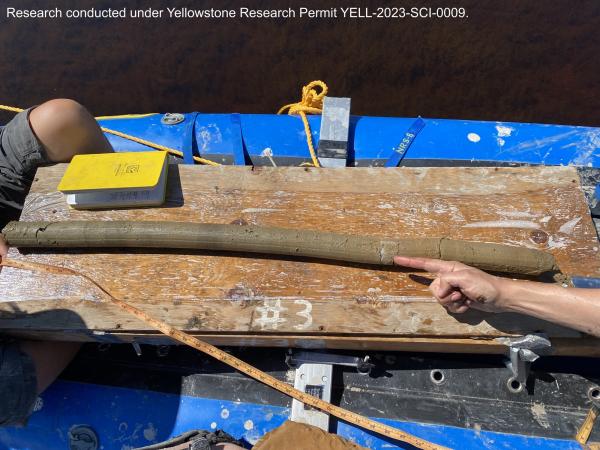Editor’s note: Yellowstone Caldera Chronicles is a weekly column written by scientists and collaborators of the Yellowstone Volcano Observatory. This week’s contribution is from Christopher Schiller, Kailey Busch, and Cathy Whitlock, all researchers at Montana State University.
Lakes hold detailed records of how landscapes have changed over time. The sediment found at the bottom of lakes, deposited layer-by-layer over thousands of years, contains the chemical and biological signatures of past environmental change. For example, arsenic and other heavy metals in Yellowstone are associated with hydrothermal activity, and their presence in lake sediments indicates that thermal features were once active in that lake’s basin.
View of Lower Geyser Basin, with Fountain and Clepsydra Geysers in eruption, looking south towards Fountain Paint Pots. The vegetation in the photo is indicative of vegetation throughout much of Lower Geyser Basin—open grassland maintained by hot ground with patches of lodgepole pine. Photo taken by Diane Renkin (NPS), June 7, 2018 (https://www.flickr.com/photos/yellowstonenps/28291478887/in/album-721576…).
This is exactly what Montana State University (MSU) researchers found in June 2018, when they collected a core from Goose Lake, the largest lake in Lower Geyser Basin, that contained sediment deposited over the past 9,300 years. Sediment cores are vertical samples of a sedimentary record that preserve a depositional sequence, with younger sediments at the top and older sediments at the bottom. Analyses of the Goose Lake core revealed that the sediments older than 3,800 years had high concentrations of arsenic, whereas younger sediments had very little arsenic. Although there are none in the immediate area today, thermal features must have once been active within or very near Goose Lake before 3,800 years ago.
The pollen and charcoal found in the same sediment core revealed that the ecosystem was impacted by this change. Lower Geyser Basin apparently supported a dense pine forest, much like Yellowstone’s Central Plateau. After 3,800 years ago, the vegetation in the basin began to open, reminiscent of how Lower Geyser Basin appears today, where a mostly treeless landscape of stunted herbs and specialized grasses is maintained by the hot ground.

A portion of organic-rich lake mud recovered from Rush Lake, in the Lower Geyser Basin of Yellowstone National Park. Younger sediments are to the left and older sediments are to the right. The researcher is pointing to a thin, white layer—the Mazama ash, produced during the eruption 7600 years ago that formed Crater Lake in Oregon. Photo taken by Chiara Smythies, August 14, 2023.
What caused this sudden reorganization of the ancestral Lower Geyser Basin? The answer is not immediately clear. Based on observations after the 1959 Hebgen Lake Earthquake, researchers know that earthquakes change Yellowstone’s hydrothermal systems on a broad scale. But hydrothermal systems are also impacted by changing climate. For example, analyses of trees that once grew in the mound of Old Faithful suggested that the geyser ceased to erupt during a multidecadal drought in the 13th and 14th centuries, and more pronounced dry periods in the distant past may have had an even greater impact.
To test which of these mechanisms might be responsible for changes 3,800 years ago, MSU scientists returned to Lower Geyser Basin to core new lakes for comparison with records of ancient earthquakes and climate change. Field work began in August of last year. Each lake brought new surprises!
- Rush Lake is small, shallow lake surrounded by mud pots and fumaroles that likely formed in a hydrothermal explosion. The core contains thick deposits of clay and gravel, which may be the product of hydrothermal activity, and finely laminated sediments (layers that are very thin, less than 1 centimeter [3/8 inch]) from seasonal glacial melt or pulsating hydrothermal activity at the end of the last ice age.
- Lower Basin Lake, south of the Firehole River, has floating algal mats on its surface but no visible hydrothermal activity. The core shows wetland sediment lying beneath recent lake deposits, suggesting that a significant change in water level occurred in the recent past.
- Feather Lake, near Goose Lake, has no thermal activity today, but thick clay deposits may be the result of ancient hydrothermal input.
- Harlequin Lake, in the Madison Canyon, provides a control lake without nearby hydrothermal features. The bottom of core is composed of coarse gravels (likely deposited by landslides) and deposits of charcoal. It is possible that an ancient fire destabilized the slope above the lake, causing the landslide.

Section of a sediment core from Rush Lake, Lower Geyser Basin, Yellowstone National Park. Thick gravel to the left (black-gray) is the product of a hydrothermal explosion that occurred in Lower Geyser Basin more than 13,500 years ago, and fine laminations to the right (very fine layering) may be the product of seasonal glacier melt, pulses of hydrothermal activity, or something else. Photo taken by Christopher Schiller, September, 2023.
This research is part of a three-year interdisciplinary collaboration between scientists at Montana State University, USGS, Defiance College, and the New Mexico Bureau of Geology and Mineral Resources. In the coming months, cores will be microscopically examined to determine their basic components—peat or mud, brown or green algae, clay or silt. X-ray fluorescence scanning will reveal the elemental composition of the sediments, including the concentration of arsenic, antimony, and other heavy metals indicative of hydrothermal activity. Fossil pollen and particulate charcoal will be studied to reconstruct the vegetation and fire history of the basin. Changes in the chemistry and species of diatoms, brown algae, can teach us about changing lake conditions, including those related to climate. The age of specific changes will be determined from radiocarbon dates of fossil plant debris in the cores. These new lines of evidence will reveal not only where and when thermal activity changed in this part of Yellowstone National Park, but also allow us to test what mechanisms were responsible—climate or something else?
This project is supported by National Science Foundation grant EAR-2149482. Field work was conducted under Yellowstone National Park permit YELL-2023-SCI-0009.





